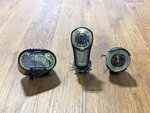While visiting my buddy Chris Nolte at Propel Bikes in Brooklyn, NY we spent some time talking about bicycle lights. Chris runs an electric bike shop, so most of the models we looked at had the option to wire-in some lights to run off of the ebike battery. Some of these lights would work just fine on their own, being powered by independent rechargeable cells. Many electric bikes come with lights already wired in. I hope this guide helps you understand why lights for bikes are important, what some of the options are, and why ebikes can be a great choice for commuting in different conditions. They help you go further, carry more weight without struggle, and can be convenient in low light night/morning conditions if they do have lights. The video overview below includes many different light products, some preinstalled and others aftermarket with clamps to work with ebike computers like the Bosch Intuvia:
Popular brands we covered here include:
In closing, many states actually require you to have lights on your bike by law. New York is one such state. Many newer ebikes actually have "always on" daytime running lights (DRL) following automobiles. The LEDs don't use that much energy, and it could save your life, but sometimes it's also annoying, so I appreciate bikes that let you turn them off manually if you want. Usually, ebike shops can show you how to do this or update your software to make it possible (if you've got a Bosch powered ebike especially). Many of the fancier headlights from Germany have a design that aims down, so it won't blind oncoming traffic. As always, I really appreciate your input and additions to this guide! I realize that we only really scratched the surface here and new products come out all of the time. Chime in below and feel free to share your own pictures and tips

Popular brands we covered here include:
- Busch & Müller ($40 to $120), can be seen on Riese & Müller products, official website at https://www.bumm.de/en/
- Supernova M99 Pro ($449) can be seen on the Stromer ST2 S and R&M Delite GX Rohloff, official website at https://supernova-lights.com/en/
- Supernova E3 E-Bike V6s ($149) can be seen on many Riese & Müller models, official website at https://supernova-lights.com/en/
- Light & Motion official website at https://www.lightandmotion.com/ at 5:33 in video
- Fuxon has a lot of decent headlights that I've been seeing on BULLS electric bike models, and they do have the side window cutouts. These lights tend to be plastic vs. metal for the more premium products. They alloy does add to your bikes weight and the cost, so it's not necessarily always better.
- Tern has a cool proprietary headlight that fits on their Andros adjustable stem on the Vektron ebike that allows you to physically turn the light on or off. You can see my review of this at https://electricbikereview.com/tern/vektron/
In closing, many states actually require you to have lights on your bike by law. New York is one such state. Many newer ebikes actually have "always on" daytime running lights (DRL) following automobiles. The LEDs don't use that much energy, and it could save your life, but sometimes it's also annoying, so I appreciate bikes that let you turn them off manually if you want. Usually, ebike shops can show you how to do this or update your software to make it possible (if you've got a Bosch powered ebike especially). Many of the fancier headlights from Germany have a design that aims down, so it won't blind oncoming traffic. As always, I really appreciate your input and additions to this guide! I realize that we only really scratched the surface here and new products come out all of the time. Chime in below and feel free to share your own pictures and tips
